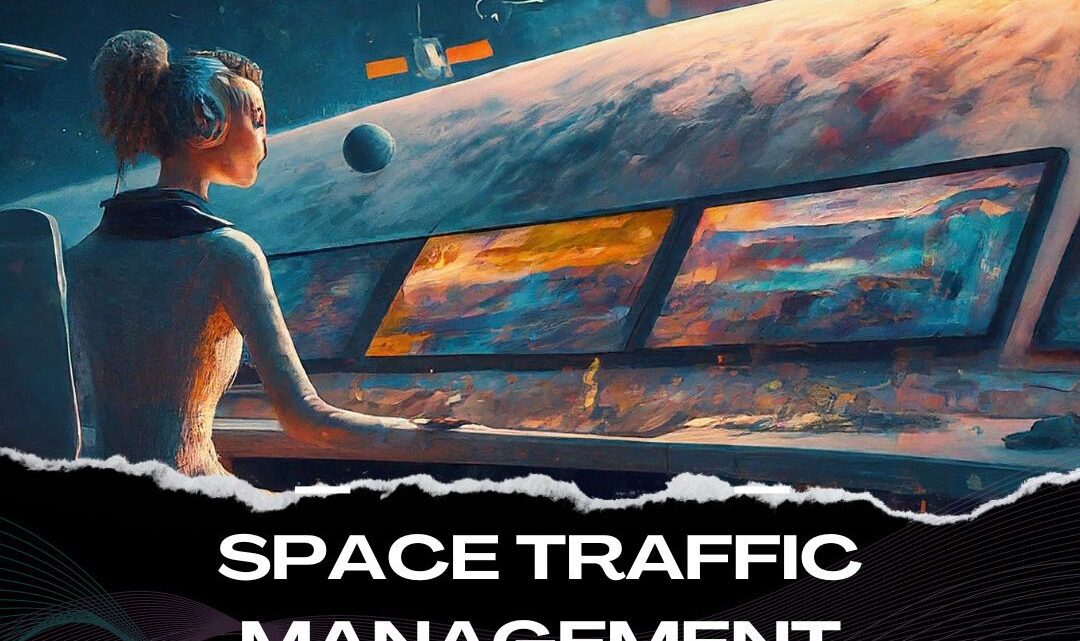Space Traffic Management (STM): Navigating the Cosmic Highway
February 16, 2024
Space Traffic Management (STM): Navigating the Cosmic Highway. In the vast expanse of the cosmos, where satellites, space debris, and celestial bodies dance their intricate orbital ballet, a new challenge emerges: Space Traffic Management (STM). As humanity’s reach into space expands, so does the need for responsible stewardship of this celestial domain. In this blog post, we delve into the intricacies of STM, exploring its significance, current initiatives, and the path forward.
What Is Space Traffic Management (STM)
Space Traffic Management encompasses the means and rules to access, conduct activities in, and return from outer space safely, sustainably, and securely. Imagine it as the cosmic air traffic control system, ensuring that our satellites, rockets, and space stations navigate the cosmic highway without collisions or interference. The stakes are high: a single collision with space debris can spell disaster for valuable assets orbiting our planet.
The Growing Challenge: Space Debris and Crowded Orbits

In 2022, the Federal Communications Commission (FCC) took a significant step by adopting a new rule: satellites in Low Earth Orbit (LEO) must deorbit within five years after completing their mission. This move aims to address the mounting issue of space debris, which poses a threat to operational satellites and future missions. Satellites launched after September 29, 2024, fall under this new five-year deorbiting mandate, a departure from the previous 25-year guideline.
But what about the situation where mass-produced, mass-launched satellites share a common defect? Enter SpaceX, a prominent player in the satellite constellation game. SpaceX proactively disposes of problematic satellites before they clutter the orbital environment. Admirable, yes, but not legally compelled. The absence of binding laws—domestic or international—leaves room for ambiguity. What if other manufacturers fail to detect flaws in advance?
The Orbital Conundrum: Sustainability and Safety
As the night sky fills with constellations of communication, Earth observation, and scientific satellites, we face a critical question: How do we ensure long-term sustainability and safety in increasingly crowded orbits? Even with good intentions, a company can inadvertently unleash chaos by deploying batches of faulty equipment. Existing rules provide a framework, but they don’t fully address the risks posed by shared flaws.
The EU Approach to Space Traffic Management

The European Union (EU) recognizes the urgency of STM. Here are the key components of the EU’s approach:
- Assessing STM Requirements: A consultation mechanism gathers civilian and military STM requirements from relevant EU partners. Understanding these needs is crucial for effective management.
- Enhancing Operational Capabilities: The EU Space Surveillance and Tracking (SST) subcomponent plays a vital role. It improves existing services, explores new technologies, and engages with the EU industry.
- Fostering Regulatory Aspects: STM regulations include non-binding measures (standards and guidelines) and binding obligations (legislation). Positive incentives encourage adherence to guidelines.
- Global Engagement: The EU promotes multilateral STM efforts, regional contributions, and dialogues with strategic partners. Space traffic knows no borders; cooperation is essential.

Space Diplomacy: Navigating International Waters
Space diplomacy enters the scene when conflicting national interests intersect. Consider the Global Positioning System (GPS) and Europe’s independent Galileo system. Negotiations, agreements, and regulations shape the future of space activities. Security, efficiency, and cooperation are paramount.
Conclusion: Charting a Course for the Stars

Space Traffic Management isn’t just about avoiding collisions; it’s about safeguarding our cosmic heritage. As we venture deeper into the final frontier, let’s steer with wisdom, foresight, and a commitment to preserving space for generations to come. The cosmic highway awaits—let’s navigate it responsibly.
References:
- European Commission: Space Traffic Management
- Wikipedia: Space Traffic Management
- The Aerospace Corporation: Space Traffic Management

What is the role of space debris in Space Traffic Management (STM)?
Space debris plays a crucial role in the realm of Space Traffic Management (STM). Let’s explore how:
- Mitigation Measures:
- Space debris poses a significant threat to operational satellites and future missions. STM actively promotes mitigation strategies to prevent the creation of new debris. By minimizing the generation of additional space junk, we reduce the risk of collisions and enhance overall safety in orbit.
- Initiatives like designing satellites with propulsion systems for controlled deorbiting after mission completion fall under this category. By adhering to these practices, we limit the accumulation of debris.
- Active Debris Removal (ADR):
- STM emphasizes the removal of existing debris from critical orbits. ADR missions aim to capture, deorbit, or relocate defunct satellites, rocket stages, and other space debris.
- Technologies like robotic arms, nets, and harpoons are being explored for ADR. These efforts contribute to decluttering congested regions in space.
- Collision Avoidance Strategies:
- STM provides guidelines for collision avoidance maneuvers. When two objects—be it operational satellites or space debris—approach dangerously close, predictive algorithms calculate potential collision points.
- Space agencies and operators receive alerts, enabling them to adjust orbits or perform evasive maneuvers. These actions prevent catastrophic collisions and preserve valuable assets.
In summary, space debris management is integral to STM. By addressing debris-related challenges, we safeguard our cosmic infrastructure and ensure the sustainable exploration of the final frontier.
How does Space Traffic Management (STM) help in satellite collision avoidance?

Space Traffic Management (STM) plays a pivotal role in ensuring the safety and integrity of our ever-expanding cosmic neighborhood. Let’s explore how STM contributes to satellite collision avoidance:
- Best Practices Handbook:
- NASA, in collaboration with U.S. Space Command, has released the Spacecraft Conjunction Assessment and Collision Avoidance Best Practices Handbook. This comprehensive guide outlines best practices for coordinating in-orbit activities safely and responsibly.
- The handbook covers various aspects, including maneuverability, tracking, reliability, and disposal of space hardware. It encourages voluntary adoption of these practices by space operators.
- Routine Collision Avoidance Maneuvers:
- In highly-trafficked orbits, spacecraft operators routinely perform collision avoidance maneuvers. These maneuvers involve sending commands to spacecraft to avoid potentially catastrophic collisions with space debris.
- As our skies become more cluttered, these proactive actions are essential for safeguarding valuable satellites and preventing collisions.
- Automated Decision-Planning:
- Advances in Space Situational Awareness (SSA) and Collision Avoidance (CA) technologies allow precise tracking and maneuvering of spacecraft. Predictive algorithms calculate potential collision points, enabling timely adjustments.
- Operators use reliable data to make informed decisions, ensuring safe distances between satellites and debris.
- Consideration of Commercial Space Situational Awareness Data:
- The best practices handbook emphasizes the use of commercially available space situational awareness data. Leveraging innovative opportunities, both commercial and non-profit, enhances existing capabilities.
- By integrating real-time data, operators can optimize collision avoidance strategies and sustain key orbital regimes.
In summary, STM acts as our cosmic air traffic control, guiding satellites away from harm’s way and promoting responsible space utilization.
Work Smarter Not Harder: Unleash Your Team’s Potential and Drive Business Growth


